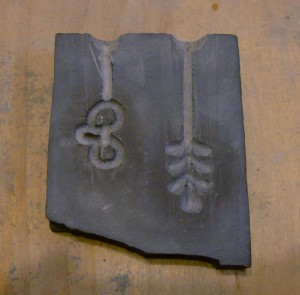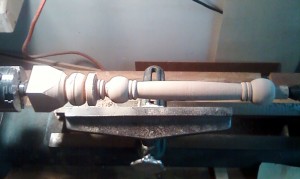I got back into Dad’s workshop this morning and finished up my new pilgrim staff.
Month: January 2012
Don Carlos Belt: Finished
I made the mold back out of a piece of scrap wood, with nails for registration pins. I needed to drill out the back for rivets on the loop terminals, and I decided to carve out the back side of the hook a little bit to give it some more thickness. To make sure everything lined up, I put a little acrylic paint on the front side of the mold, then pressed the two halves together to transfer it. It gave me enough of an idea of where the edges would line up so that I could put things in more or less the right spot. I poured up a few sets, but I started getting some discoloration in the metal (probably from impurities from the wood) so I only ended up with two usable sets of loops. I cut the old hardware off the belt and installed the new bits. So far, it looks like a winner!
Don Carlos Belt: Mold
After goofing on my first try at a new belt buckle, I decided to go back to the portraits. After looking through a bunch of images, I decided to rip off Don Carlos:

I’ve got the front of the mold carved. I need to make a back with rivets for the loop and then it’ll be time to pour some metal.
Owl Face Belt Hook: Research Fail
After making the loops for my new belt clasp, I went looking for options for the S-hook that were not snakes or swans. In the process, I ran across this link that pretty much blows a hole in the idea that the lion head belt terminals I found are actually 16th century. They seem to be more of the 18th century military belt clasp type. I’m going back through 16th century portraits now, and so far all I’m finding are surface-mounted terminals like I used on my old belt. I’m also less sure now about the zoomorphic decoration on the hooks for 16th century belts, but I think that will stand up in the end.
Edited to add: I managed to find a few examples that were clear enough to see what’s going on with the clasp. Surface mounted loops, as I expected, but also no clear evidence of the zoomorphic S-hook. There was more variety than I expected, and less surface decoration on the hooks, so that may be a blessing in disguise, from a casting standpoint. There seem to be both S-shaped hooks and sort of curvy M-shaped hooks as well…
Turned Pilgrim Staff: Beginning
A couple Pennsics ago I made myself a pilgrim’s staff to help keep weight off a dodgy ankle. It turned out to be one of my favorite accessories, both for dealing with the aches and pains of advancing age and carrying the occasional heavy load. The original was made with a broom handle and a couple of inaccurately drilled 2″ wooden balls. It was thrown together quickly before the war, along with several poorer copies. I’ve dreamed of making a better one ever since, and now the opportunity has arisen.
Recently, my dad has been playing with the lathe that’s been in his shop for as long as I can remember (and which is surely older than I am). He’s made a bunch of handles for things, as well as some nifty pens for Adela. It seems most likely to me that pilgrims’ staves were turned on a lathe rather than constructed from a stick and two knobs like I did. I’ve gathered some images of staves that have some more interesting features that I’d like on the new model. Some have a slightly bulging profile between the knobs, some have flattened doorknob-shaped knobs, and one Durer woodcut shows some decoration next to the knobs. I’d like to incorporate all of these elements if I can. Since the lathe doesn’t have enough room to work on a whole staff at once, I’m going to make a top section with a socket to attach the same sort of broom handle that I used before (and which has served quite well).
Last night I glued up some beech wood that was handy in the shop and learned how to use the lathe. It really is an addictive toy, and I stayed up almost until midnight getting the basic shape laid out. The flattened knobs didn’t quite work out, but spherical ones ended up being easier to make than I expected. The surface is still pretty rough, and beech may not have been the best choice of wood, but I’m reasonably happy with my first attempt.


